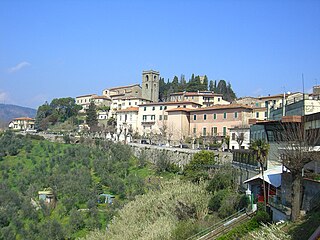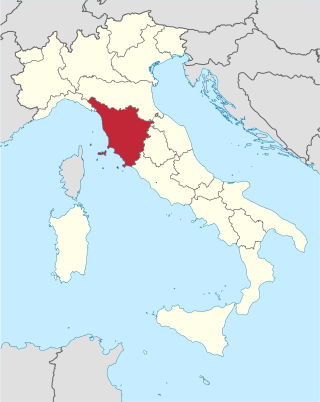
Lucca is a city and comune in Tuscany, Central Italy, on the Serchio River, in a fertile plain near the Ligurian Sea. The city has a population of about 89,000, while its province has a population of 383,957.

The Sienese School of painting flourished in Siena, Italy, between the 13th and 15th centuries. Its most important artists include Duccio, whose work shows Byzantine influence, his pupil Simone Martini, the brothers Pietro and Ambrogio Lorenzetti and Domenico and Taddeo di Bartolo, Sassetta, and Matteo di Giovanni.

The Republic of Lucca was a medieval and early modern state that was centered on the Italian city of Lucca in Tuscany, which lasted from 1160 to 1805.
The School of Ferrara was a group of painters which flourished in the Duchy of Ferrara during the Renaissance. Ferrara was ruled by the Este family, well known for its patronage of the arts. Patronage was extended with the ascent of Ercole d'Este I in 1470, and the family continued in power till Alfonso II, Ercole's great-grandson, died without an heir in 1597. The duchy was then occupied in succession by Papal and Austrian forces. The school evolved styles of painting that appeared to blend influences from Mantua, Venice, Lombardy, Bologna, and Florence.

The Bolognese School of painting, also known as the School of Bologna, flourished between the 16th and 17th centuries in Bologna, which rivalled Florence and Rome as the center of painting in Italy. Its most important representatives include the Carracci family, including Ludovico Carracci and his two cousins, the brothers Agostino and Annibale Carracci. Later, it included other Baroque painters: Domenichino and Lanfranco, active mostly in Rome, eventually Guercino and Guido Reni, and Accademia degli Incamminati in Bologna, which was run by Lodovico Carracci. Certain artistic conventions, which over time became traditionalist, had been developed in Rome during the first decades of the 16th century. As time passed, some artists sought new approaches to their work that no longer reflected only the Roman manner. The Carracci studio sought innovation or invention, seeking new ways to break away from traditional modes of painting while continuing to look for inspiration from their literary contemporaries; the studio formulated a style that was distinguished from the recognized manners of art in their time. This style was seen as both systematic and imitative, borrowing particular motifs from the past Roman schools of art and innovating a modernistic approach.

Poggibonsi is a town in the province of Siena, Tuscany, central Italy. It is located on the River Elsa and is the main centre of the Valdelsa Valley.

Montecarlo is a comune (municipality) in the Province of Lucca in the Italian region Tuscany, located about 50 kilometres (31 mi) west of Florence and about 12 kilometres (7 mi) east of Lucca.

Pietro Paolini, called il Lucchese was an Italian painter of the Baroque period. Working in Rome, Venice and finally his native Lucca, he was a follower of Caravaggio to whose work he responded in a very personal manner. He founded an Academy in his hometown, which formed the next generation of painters of Lucca.

Antonio Franchi (1638–1709) was an Italian painter of the 17th century, active mainly in Florence and Lucca.

Florentine painting or the Florentine School refers to artists in, from, or influenced by the naturalistic style developed in Florence in the 14th century, largely through the efforts of Giotto di Bondone, and in the 15th century the leading school of Western painting. Some of the best known painters of the earlier Florentine School are Fra Angelico, Botticelli, Filippo Lippi, the Ghirlandaio family, Masolino, and Masaccio.
Pietro Ricchi was an Italian painter of the Baroque period, born in Lucca.

Paolo Zacchia il Vecchio, Zacchia the elder, or Zacchia di Antonio da Vezzano (1490-1561) was an Italian painter of the Renaissance period. He was born in Vezzano Ligure and active in Lucca. He probably trained Florence, his works show influences of Domenico Ghirlandaio and Fra Bartolomeo. His son Lorenzo di Ferro Zacchia or Zacchia il Giovane was also a painter and engraver, active in Lucca.

Tuscany is a region in central Italy with an area of about 23,000 square kilometres and a population of about 3.8 million inhabitants. The regional capital is Florence (Firenze).

Berlinghiero also known as Berlinghiero Berlinghieri or Berlinghiero of Lucca, was an Italian painter in the Italo-Byzantine style of the early thirteenth century. He was the father of the painters Barone Berlinghieri, Bonaventura Berlinghieri, and Marco Berlinghieri.

The Ducal Palace is a palace in Lucca, Tuscany, central Italy.

Lucchese 1905 s.r.l., or simply Lucchese, is an Italian football club, based in Lucca, Tuscany that plays in Serie C, the third tier of Italian football. The club was first founded in 1905, having last been in Serie A in 1952.
The University of Lucca was an Italian university located in Lucca (LU), Italy, established in 1785 by the government of the Republic of Lucca. The university disappearing for good in 1867. There had previously been several attempts in the medieval period to found a University of Lucca: On 6 June 1369 Emperor Charles IV granted Lucca a charter for the establishment of a Studium Generale, confirmed on 13 September 1387 by Pope Urban VI. No university was actually founded, but again in 1455 Gonfalonier Giovanni Gigli tried to raise funds for a university, but once more it did not result in an actual institution.

Michele Ciampanti was an Italian painter active mainly in Lucca. This painter has been identified as matching Berenson's putative Master of Stratonice, and is also called Michele di Michele Ciampanti.

Italo-Byzantine is a style term in art history, mostly used for medieval paintings produced in Italy under heavy influence from Byzantine art. It initially covers religious paintings copying or imitating the standard Byzantine icon types, but painted by artists without a training in Byzantine techniques. These are versions of Byzantine icons, most of the Madonna and Child, but also of other subjects; essentially they introduced the relatively small portable painting with a frame to Western Europe. Very often they are on a gold ground. It was the dominant style in Italian painting until the end of the 13th century, when Cimabue and Giotto began to take Italian, or at least Florentine, painting into new territory. But the style continued until the 15th century and beyond in some areas and contexts.















